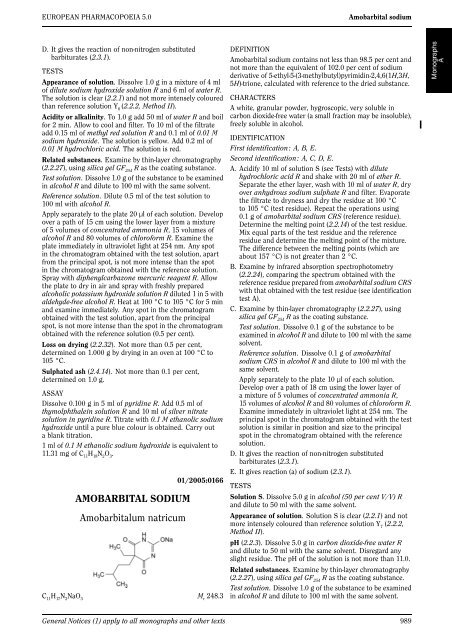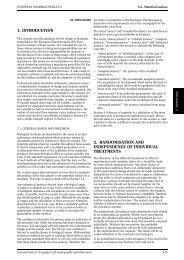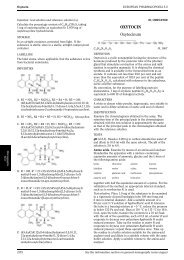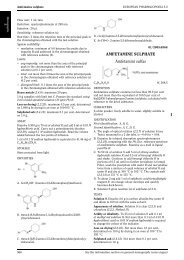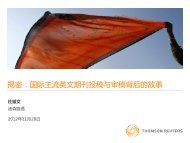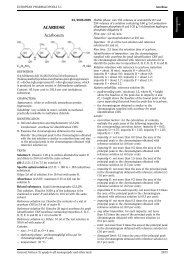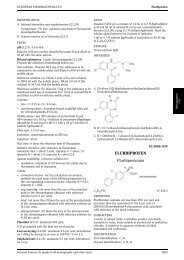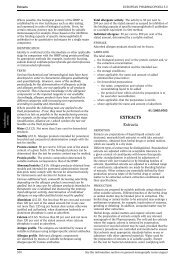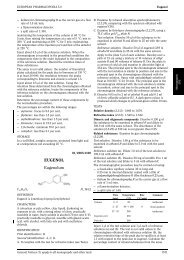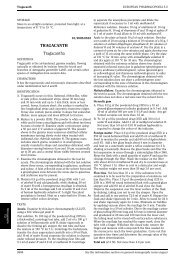Amobarbital sodium.pdf
Amobarbital sodium.pdf
Amobarbital sodium.pdf
You also want an ePaper? Increase the reach of your titles
YUMPU automatically turns print PDFs into web optimized ePapers that Google loves.
EUROPEAN PHARMACOPOEIA 5.0<br />
<strong>Amobarbital</strong> <strong>sodium</strong><br />
D. It gives the reaction of non-nitrogen substituted<br />
barbiturates (2.3.1).<br />
TESTS<br />
Appearance of solution. Dissolve1.0ginamixtureof4ml<br />
of dilute <strong>sodium</strong> hydroxide solution R and 6 ml of water R.<br />
The solution is clear (2.2.1) and not more intensely coloured<br />
than reference solution Y 6<br />
(2.2.2, Method II).<br />
Acidity or alkalinity. To1.0gadd50mlofwater R and boil<br />
for 2 min. Allow to cool and filter. To 10 ml of the filtrate<br />
add 0.15 ml of methyl red solution R and 0.1 ml of 0.01 M<br />
<strong>sodium</strong> hydroxide. The solution is yellow. Add 0.2 ml of<br />
0.01 M hydrochloric acid. Thesolutionisred.<br />
Related substances. Examine by thin-layer chromatography<br />
(2.2.27), using silica gel GF 254<br />
R as the coating substance.<br />
Test solution.Dissolve1.0gofthesubstancetobeexamined<br />
in alcohol R and dilute to 100 ml with the same solvent.<br />
Reference solution. Dilute 0.5 ml of the test solution to<br />
100 ml with alcohol R.<br />
Apply separately to the plate 20 µl of each solution. Develop<br />
over a path of 15 cm using the lower layer from a mixture<br />
of 5 volumes of concentrated ammonia R, 15 volumes of<br />
alcohol R and 80 volumes of chloroform R. Examinethe<br />
plate immediately in ultraviolet light at 254 nm. Any spot<br />
in the chromatogram obtained with the test solution, apart<br />
from the principal spot, is not more intense than the spot<br />
in the chromatogram obtained with the reference solution.<br />
Spray with diphenylcarbazone mercuric reagent R. Allow<br />
the plate to dry in air and spray with freshly prepared<br />
alcoholic potassium hydroxide solution R diluted 1 in 5 with<br />
aldehyde-free alcohol R. Heatat100°Cto105°Cfor5min<br />
and examine immediately. Any spot in the chromatogram<br />
obtained with the test solution, apart from the principal<br />
spot, is not more intense than the spot in the chromatogram<br />
obtained with the reference solution (0.5 per cent).<br />
Loss on drying (2.2.32). Not more than 0.5 per cent,<br />
determined on 1.000 g by drying in an oven at 100 °C to<br />
105 °C.<br />
Sulphated ash (2.4.14). Not more than 0.1 per cent,<br />
determined on 1.0 g.<br />
ASSAY<br />
Dissolve 0.100 g in 5 ml of pyridine R. Add 0.5 ml of<br />
thymolphthalein solution R and 10 ml of silver nitrate<br />
solution in pyridine R. Titratewith0.1 M ethanolic <strong>sodium</strong><br />
hydroxide until a pure blue colour is obtained. Carry out<br />
a blank titration.<br />
1mlof0.1 M ethanolic <strong>sodium</strong> hydroxide is equivalent to<br />
11.31 mg of C 11<br />
H 18<br />
N 2<br />
O 3<br />
.<br />
AMOBARBITAL SODIUM<br />
<strong>Amobarbital</strong>um natricum<br />
01/2005:0166<br />
C 11<br />
H 17<br />
N 2<br />
NaO 3<br />
M r<br />
248.3<br />
DEFINITION<br />
<strong>Amobarbital</strong> <strong>sodium</strong> contains not less than 98.5 per cent and<br />
not more than the equivalent of 102.0 per cent of <strong>sodium</strong><br />
derivative of 5-ethyl-5-(3-methylbutyl)pyrimidin-2,4,6(1H,3H,<br />
5H)-trione, calculated with reference to the dried substance.<br />
CHARACTERS<br />
A white, granular powder, hygroscopic, very soluble in<br />
carbon dioxide-free water (a small fraction may be insoluble),<br />
freely soluble in alcohol.<br />
IDENTIFICATION<br />
First identification: A, B, E.<br />
Secondidentification:A,C,D,E.<br />
A. Acidify 10 ml of solution S (see Tests) with dilute<br />
hydrochloric acid R and shake with 20 ml of ether R.<br />
Separate the ether layer, wash with 10 ml of water R, dry<br />
over anhydrous <strong>sodium</strong> sulphate R and filter. Evaporate<br />
thefiltratetodrynessanddrytheresidueat100°C<br />
to 105 °C (test residue). Repeat the operations using<br />
0.1 g of amobarbital <strong>sodium</strong> CRS (reference residue).<br />
Determine the melting point (2.2.14) of the test residue.<br />
Mix equal parts of the test residue and the reference<br />
residueanddeterminethemeltingpointofthemixture.<br />
The difference between the melting points (which are<br />
about 157 °C) is not greater than 2 °C.<br />
B. Examine by infrared absorption spectrophotometry<br />
(2.2.24), comparing the spectrum obtained with the<br />
reference residue prepared from amobarbital <strong>sodium</strong> CRS<br />
with that obtained with the test residue (see identification<br />
test A).<br />
C. Examine by thin-layer chromatography (2.2.27), using<br />
silica gel GF 254<br />
R as the coating substance.<br />
Test solution. Dissolve 0.1 g of the substance to be<br />
examined in alcohol R anddiluteto100mlwiththesame<br />
solvent.<br />
Reference solution. Dissolve 0.1 g of amobarbital<br />
<strong>sodium</strong> CRS in alcohol R and dilute to 100 ml with the<br />
same solvent.<br />
Apply separately to the plate 10 µl of each solution.<br />
Develop over a path of 18 cm using the lower layer of<br />
a mixture of 5 volumes of concentrated ammonia R,<br />
15 volumes of alcohol R and 80 volumes of chloroform R.<br />
Examine immediately in ultraviolet light at 254 nm. The<br />
principal spot in the chromatogram obtained with the test<br />
solution is similar in position and size to the principal<br />
spot in the chromatogram obtained with the reference<br />
solution.<br />
D. It gives the reaction of non-nitrogen substituted<br />
barbiturates (2.3.1).<br />
E. It gives reaction (a) of <strong>sodium</strong> (2.3.1).<br />
TESTS<br />
Solution S. Dissolve5.0ginalcohol (50 per cent V/V) R<br />
and dilute to 50 ml with the same solvent.<br />
Appearance of solution. Solution S is clear (2.2.1) andnot<br />
more intensely coloured than reference solution Y 7<br />
(2.2.2,<br />
Method II).<br />
pH (2.2.3). Dissolve 5.0 g in carbon dioxide-free water R<br />
and dilute to 50 ml with the same solvent. Disregard any<br />
slight residue. The pH of the solution is not more than 11.0.<br />
Related substances. Examine by thin-layer chromatography<br />
(2.2.27), using silica gel GF 254<br />
R as the coating substance.<br />
Test solution.Dissolve1.0gofthesubstancetobeexamined<br />
in alcohol R and dilute to 100 ml with the same solvent.<br />
GeneralNotices(1)applytoallmonographsandothertexts 989
Amoxicillin <strong>sodium</strong> EUROPEAN PHARMACOPOEIA 5.0<br />
Reference solution. Dilute 0.5 ml of the test solution to<br />
100 ml with alcohol R.<br />
Apply separately to the plate 20 µl of each solution. Develop<br />
over a path of 15 cm using the lower layer of a mixture<br />
of 5 volumes of concentrated ammonia R, 15volumes<br />
of alcohol R and 80 volumes of chloroform R. Examine<br />
the plate immediately in ultravioletlightat254nm.Spray<br />
with diphenylcarbazone mercuric reagent R. Allowthe<br />
plate to dry in air and spray with freshly prepared alcoholic<br />
potassium hydroxide solution R diluted 1 in 5 with<br />
aldehyde-free alcohol R. Heatat100°Cto105°Cfor5min<br />
and examine immediately. When examined in ultraviolet<br />
light and after spraying, any spot in the chromatogram<br />
obtained with the test solution, apart from the principal<br />
spot, is not more intense than the spot in the chromatogram<br />
obtained with the reference solution (0.5 per cent). Disregard<br />
any spot at the starting-point.<br />
Loss on drying (2.2.32). Not more than 3.0 per cent,<br />
determinedon0.50gbydryinginanovenat130°C.<br />
ASSAY<br />
Dissolve 0.200 g in 5 ml of ethanol R. Add0.5mlof<br />
thymolphthalein solution R and 10 ml of silver nitrate<br />
solution in pyridine R. Titratewith0.1 M ethanolic <strong>sodium</strong><br />
hydroxide until a pure blue colour is obtained. Carry out<br />
a blank titration.<br />
1mlof0.1 M ethanolic <strong>sodium</strong> hydroxide is equivalent to<br />
24.83 mg of C 11<br />
H 17<br />
N 2<br />
NaO 3<br />
.<br />
STORAGE<br />
Storeinanairtightcontainer.<br />
AMOXICILLIN SODIUM<br />
Amoxicillinum natricum<br />
01/2005:0577<br />
corrected<br />
C 16<br />
H 18<br />
N 3<br />
NaO 5<br />
S M r<br />
387.4<br />
DEFINITION<br />
Amoxicillin <strong>sodium</strong> contains not less than 89.0 per<br />
cent and not more than the equivalent of 102.0 per<br />
cent of <strong>sodium</strong> (2S,5R,6R)-6-[[(2R)-2-amino-2-(4-<br />
hydroxyphenyl)acetyl]amino]-3,3-dimethyl-7-oxo-4-thia-1-<br />
azabicyclo[3.2.0]heptane-2-carboxylate, calculated with<br />
reference to the anhydrous substance.<br />
CHARACTERS<br />
A white or almost white powder, very hygroscopic, very<br />
soluble in water, sparingly soluble in ethanol, very slightly<br />
soluble in acetone.<br />
IDENTIFICATION<br />
First identification: A, D.<br />
Second identification: B, C, D.<br />
A. Dissolve 0.250 g in 5 ml of water R, add0.5mlofdilute<br />
acetic acid R, swirlandallowtostandfor10mininiced<br />
water. Filter the crystals and wash with 2 ml to 3 ml<br />
of a mixture of 1 volume of water R and 9 volumes of<br />
acetone R, then dry in an oven at 60 °C for 30 min.<br />
Examine by infrared absorption spectrophotometry<br />
(2.2.24), comparing with the spectrum obtained with<br />
amoxicillin trihydrate CRS.<br />
B.Examinebythin-layerchromatography(2.2.27), using a<br />
TLC silanised silica gel plate R.<br />
Test solution. Dissolve25mgofthesubstancetobe<br />
examined in 10 ml of <strong>sodium</strong> hydrogen carbonate<br />
solution R.<br />
Reference solution (a). Dissolve25mgofamoxicillin<br />
trihydrate CRS in 10 ml of <strong>sodium</strong> hydrogen carbonate<br />
solution R.<br />
Reference solution (b). Dissolve25mgofamoxicillin<br />
trihydrate CRS and 25 mg of ampicillin trihydrate CRS<br />
in 10 ml of <strong>sodium</strong> hydrogen carbonate solution R.<br />
Apply to the plate 1 µl of each solution. Develop over a<br />
path of 15 cm using a mixture of 10 volumes of acetone R<br />
and 90 volumes of a 154 g/l solution of ammonium<br />
acetate R, the pH of which has been adjusted to 5.0 with<br />
glacial acetic acid R. Allow the plate to dry in air and<br />
expose it to iodine vapour until the spots appear. Examine<br />
in daylight. The principal spot in the chromatogram<br />
obtained with the test solution is similar in position,<br />
colour and size to the principal spot in the chromatogram<br />
obtained with reference solution (a). The test is not<br />
valid unless the chromatogram obtained with reference<br />
solution (b) shows 2 clearly separated spots.<br />
C. Place about 2 mg in a test-tube about 150 mm long and<br />
15 mm in diameter. Moisten with 0.05 ml of water R and<br />
add 2 ml of sulphuric acid-formaldehyde reagent R.<br />
Mix the contents of the tube by swirling; the solution is<br />
practically colourless. Place the test-tube in a water-bath<br />
for 1 min; a dark yellow colour develops.<br />
D. It gives reaction (a) of <strong>sodium</strong> (2.3.1).<br />
TESTS<br />
Appearance of solution. Dissolve1.0ginwater R and<br />
dilute to 10.0 ml with the same solvent. Immediately after<br />
dissolution, the solution is not more opalescent than<br />
reference suspension II (2.2.1). The solution may show an<br />
initial, but transient, pink colour. After 5 min, the absorbance<br />
measured at 430 nm (2.2.25) is not greater than 0.20.<br />
pH (2.2.3). Dissolve 2.0 g in carbon dioxide-free water R<br />
and dilute to 20 ml with the same solvent. The pH of the<br />
solution is 8.0 to 10.0.<br />
Specific optical rotation (2.2.7).Dissolve62.5mgina4g/l<br />
solution of potassium hydrogen phthalate R and dilute to<br />
25.0 ml with the same solution. The specific optical rotation<br />
is+240to+290,calculatedwithreferencetotheanhydrous<br />
substance.<br />
Related substances. Examinebyliquidchromatography<br />
(2.2.29) as described under Assay. Inject 50 µl of reference<br />
solution (d) and elute isocratically until elution of the<br />
amoxicillin peak. Inject 50 µl of test solution (b) and start<br />
the elution isocratically. Immediately after elution of the<br />
amoxicillin peak start the following linear gradient. If the<br />
mobile phase composition has been adjusted to achieve the<br />
required resolution, the adjusted composition will apply at<br />
time zero in the gradient.<br />
Time<br />
(min)<br />
Mobile phase A<br />
(per cent V/V)<br />
Mobile phase B<br />
(per cent V/V)<br />
Comment<br />
0-25 92 → 0 8 → 100 linear gradient<br />
25 - 40 0 100 isocratic<br />
40 - 55 92 8 re-equilibration<br />
990 See the information section on general monographs (cover pages)


